When I signed up for this trip, I expected to explore the Caraga region that includes the five provinces of the Sur and Norte parts of Surigao and Agusan, as well as Dinagat Island. Little did I know that in the province of Davao Oriental, there is a municipality also called Caraga that claims its name from the word kalagan, which in native language refers to a "spirited person.”
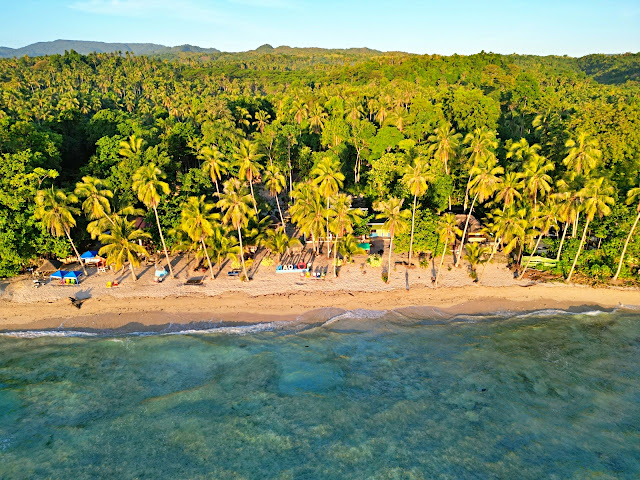 |
| A typical shoreline in Caraga. |
Having my geographical assumptions about our destination proven wrong has never made me gladder. I began to experience the unparalleled sense of anticipation I always feel whenever I visit a new destination as we set out on a long road trip from Davao City. In this case, to a quaint town where the easternmost tip of the country is also located, as well as a plethora of breathtaking natural landscapes and diverse customs and traditions.
Before Sunrise
After a relaxed first day highlighted by gorging on local cuisine, we woke up extra early the next morning to witness the day’s earliest sunrise in the country. Facing the Pacific Ocean, a jagged stretch of rocky cliff called Pusan Point is where one can witness the first daybreak in the Philippines.
 |
| On a clear day, the country's first sunrise can be seen here |
The Pusan Point marks the easternmost part of the Philippines and where the sun rises at its earliest in the country. During the morning of January 1, 2000, many people gathered here to witness the first sunrise of the millennium. A lighthouse, a sundial, an ampitheater and a cross currently rises amidst the steep cliffs where also the waves of the Pacific Ocean first crashes into the Philippines.
Chasing Waterfalls
A local tourism official told us that there is currently more than 40 documented waterfalls found in Caraga and more are still being explored. With only five days of exploring Caraga we were fortunate to have visited at least three waterfalls.
 |
| Staring at the majestic Kyabatangan Waterfalls. |
The first one, the multi-tiered Kyabatangan Falls, which spills into a 25–30-foot drop to a big and inviting pool, made the bumpy ride going here worthwhile. While the phrase “hidden gem” already make people doubt it every time its mentioned, this waterfall truly exemplifies what it means because of its secluded setting and absorbing appearance like something out of a fairy-tale book.
 |
| Agosais Falls |
Located on the same road leading to Kyabatangan Falls, the much taller and more isolated Agosais Falls can be seen plunging its clear waters down the mountainside, encircled by towering trees, appearing more majestic in the embrace of Mother Nature.
 |
| Moments before taking a refreshing dip. |
We set out on foot the following morning to reach Kapuka Falls, which is almost 160 feet tall. The path was difficult, with hazards such as a slick descent pathway, crawling over stones, and fording a river with a shallow depth but strong current that cuts through the barangay of Lamiawan. Despite my missteps, I finally reached the plunge pool of Kapuka Falls, where I was able to take in the breathtaking scenery and cool off in its Gatorade blue-colored waters. We could have spent an extra hour hiking to Ugwad Falls, which is just a few kilometers away, had we had more time.
Chill and Surf
Since the municipality of Caraga is edged by a long shoreline facing the Pacific Ocean, it shouldn’t come as no surprise to discover several surfing spots in Caraga. The main one is found on the long stretch of San Luis Beach which supplies endless swells for both seasoned and beginner surfers. The powdery gray sands also makes it an ideal beach to bum around and swim as well.
 |
| Surfers gathers on the line-up |
Not far away, there are a few other beaches worth seeing. The Pantad Tide Pool, south of Caraga, conceals a series of natural pools that are visible during low tide. It is preferable to visit around low tide so that you can sink into the natural pool whenever the splashing waves pulls back to the ocean.
 |
| The long stretch of Mabiga Beach |
Mabiga beach has a couple of quaint resorts, Villa Mabiga and Elah Moana, where one can relax under a tree or in a hammock and engage one of its owners, an irrepressible New Zealander who boasts of amazing scuba diving stories and has written a draft of a book titled "Rough Guide to Treasure Hunting" that he hopes to publish one day.
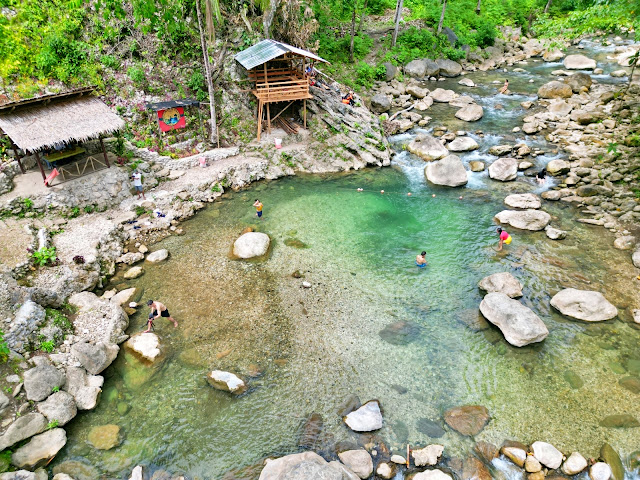 |
| Batinao's Haven, a campground river provides a spot ideal for a soothing dip |
A Dose of Local Culture
Amidst the many wonderful great outdoor attractions in Caraga, the municipality is proud of its local history and culture.
 |
| The San Salvador Del Mundo Parish Church |
For history enthusiasts, one shouldn't miss the San Salvador Del Mundo Parish Church. Built by the Jesuits in 1884 from stones and wood, it is the oldest Catholic church in Mindanao today. The National Historical Commission of the Philippines (NHCP) designated it a National Historic Site in 2012.
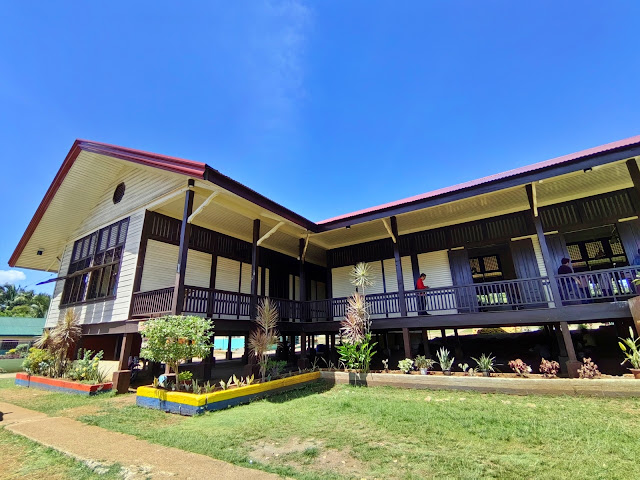 |
| The distinct Architecture of a Gabaldon School is visible in the exterior of Caraga Elementary School |
Inside, are a number of items dating back centuries, including the Church's bell, which was cast in 1802, the old Baptismal registry, the ruins of the old rectory, which was briefly used as a prison near the end of Spanish rule, and the original statue of San Isidro Labrador, the town's patron saint.
 |
| A Mandaya young woman demonstrate the Dagmay weaving process |
The Caraga Elementary School is another interesting place of interest. It is one of the few remaining and intact Gabaldon schools in the Philippines. Gabaldon schools are considered heritage structures because it was built during the American colonial era. Traditional Filipino dwellings, known as bahay kubo and bahay na bato, serve as inspiration for these schools' distinct architecture style.
 |
| Members of the Mandaya Community poses with their weaving kits given by the Tourism Promotions Board of the Philippines during a Community Based Workshop conducted by the TPB |
To learn more about the culture and traditions of Caraga, better pay a visit to the community of the Mandaya Ethnic Group in Sitio Sangab, their ancestral domain in the Caraga municipality, Davao Oriental.
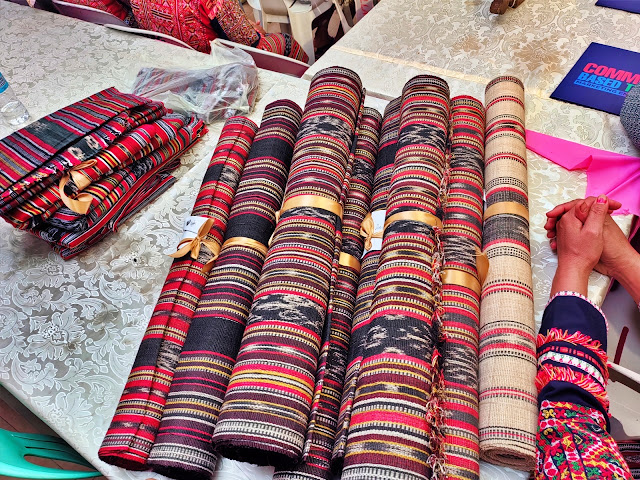 |
| You can buy some of these wonderful Dagmay cloth at the Mandaya community in Sitio Sangab |
One of the eleven Indigenous Peoples' communities in the Davao Region, the Mandaya are known as "inhabitants of the upland" and have one of the best-preserved cultures. The Mandaya's vibrant Dagmay cloth and elaborate embroidery are symbols of their rich cultural heritage. Led by their young chieftain Maigen Christine Banugan, the community also educates visitors on the proper use and wearing of their dagmay cloth creations as part of their cultural sensitivity advocacy.
 |
| One of the Mandaya women who participated in the TPB CBT workshop. |
After you’ve seen the community, the Mandaya Educational Research on Heritage beside Colegio de Caraga should be next on your list. It is a modest museum that preserves historical relics, musical instruments, traditional attire, and written works that are extremely important to the cultural practices and traditions of the Mandayan people.
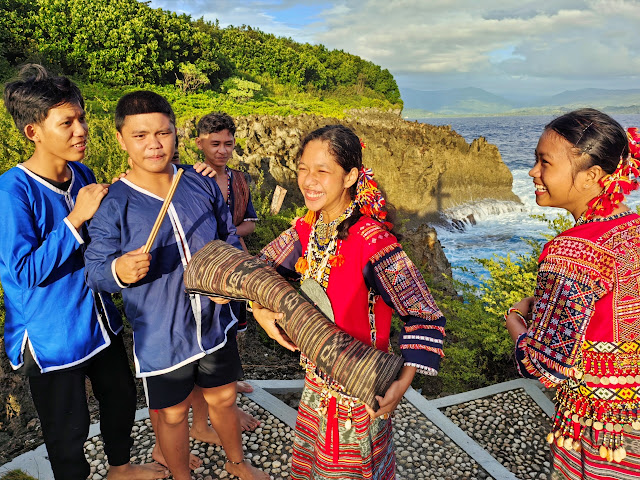 |
| Young members of the Mandaya community who accompanied us to Pusan Point to witness the sunrise. |
If you’re fortunate to time your visit when you can meet Norma Gonos, an Indigenous People Affair Consultant. You can then make the most of the opportunity by listening to her speak at length about Mandaya culture and how to be respectful of other cultures when using or wearing their creations.
Having spent many days winding through Caraga's picturesque highways, rugged roads, and hiking trails, I became well-acquainted with the region's breathtaking natural scenery and learned a great deal about the homegrown culture, which continues to this day to serve as an inspiration to other creative communities across Mindanao and the Philippines.
This article first appeared on the print and online issue of BusinessMirror
Klook.com





















